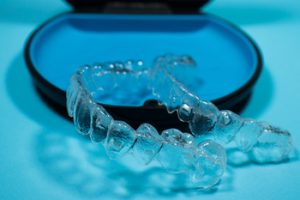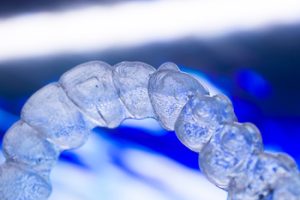Invisalign Pros and Cons — Everything You Need To Know

Are you having trouble choosing between traditional braces and clear aligners? Clear aligners have become a go-to for people wanting to get straighter, healthier smiles. Don’t worry—you’re not alone in this preference.
Let’s take a closer look at how Invisalign can help you and the potential drawbacks of using this product so that you have all the information needed to make an informed decision regarding its suitability for your needs.
What is Invisalign?
Invisalign is a new way to fix teeth that are different. It uses clear plastic trays to move teeth into place slowly, just like metal braces, but you can’t see them as much.
In addition to being safe and comfortable, this patented product of the Invisalign brand is easy to use and remove.
These custom-made aligners improve dental alignment without compromising your smile or day-to-day lifestyle.
What kind of teeth problems can Invisalign help fix?
Crooked teeth
 Cosmetic concerns motivate many people to correct crooked teeth, but optimal dental health is another important reason to straighten your smile.
Cosmetic concerns motivate many people to correct crooked teeth, but optimal dental health is another important reason to straighten your smile.
Correcting the alignment of your teeth can prevent crooked or misaligned teeth from wearing down tooth enamel, giving you headaches and jaw pain and making it hard to clean your teeth properly.
Overbite
An overbite can arise when the upper set of front teeth extends excessively beyond their counterparts below. Although some degree of overlap is common, severe cases may lead to problems with chewing and even jaw discomfort.
Underbite
If the lower teeth protrude in front of the upper ones, a person is said to have an underbite.
This phenomenon can be caused by the bottom jaw being too far forward, resulting in accelerated or uneven tooth erosion, chewing impediments, and speech issues.
Open bite
If you suffer from an open bite, your top and bottom teeth don’t touch when your mouth is closed.
This can cause much trouble while eating meals, as even taking a single bite might seem impossible. Chewing food can also be extremely arduous.
Crossbite
Having your upper teeth rest inside the lower teeth when you close your mouth is referred to as a crossbite, leading to tooth wear or chipping, gum pain, and bone loss due to receding gums.
If left untreated for too long, this condition will worsen over time.
Gaps between the teeth
When your mouth has too much space, gaps can form between teeth. These unattractive gaps detract from one’s smile and make it more difficult to clean away food particles, increasing the risk of developing gum disease and tooth decay.
Crowded teeth
When the jaw does not have enough room, teeth can become crooked and overlap one another. This lack of interdental space may trap food particles, potentially leading to tooth decay.
What types of issues cannot be corrected by Invisalign?
Rotated teeth
When teeth are crowded together, they can become rotated; however, if a tooth exceeds 20 degrees of rotation, then it cannot be straightened with clear aligners.
Large gaps between teeth
For gaps no wider than 6 mm, Invisalign will do the trick – if yours is larger, braces or surgery may be necessary to produce a successful result.
Midline movements
For some, their front teeth are misaligned from the midline of their face. Thankfully, Invisalign can help by shifting them 2 millimetres in either direction—a seemingly minor change that makes a big difference.
What’s involved with wearing them?
If you’re interested in straightening your teeth, the first step is to schedule an appointment with a dentist.
They will take 3-D images of your mouth and jaw, which they’ll use to craft a personalised treatment plan for moving your teeth into their desired alignment.
Once this has been established, custom plastic aligners are created that apply pressure on the targeted areas of the mouth while gradually shifting them into place.
You must wear these braces at least 20-22 hours per day – changing out one batch every week or two as directed by your dentist – in order to achieve optimal results from the procedure.
What can affect how well Invisalign works?
To guarantee that Invisalign works correctly, you must wear clear braces for about 20 to 22 hours every day.
You can only take them out when you eat, drink, clean, or brush your teeth.
Pay attention while washing them, though; if you use hot water, it could distort the plastic, which will impede your progress and reduce the effectiveness of this treatment.
The severity of your orthodontic issues may also determine how successful Invisalign will be for you.
More challenging spacing or bite problems could extend the timeline until the desired results are achieved.
Your biological sex and age may also influence your Invisalign treatment results.
Invisalign pros and cons
Let’s see the good and bad things about Invisalign to figure out if it’s the best choice for you.
Pros of Invisalign
- Not only are these clear aligners significantly less visible than traditional braces, but they also have the added bonus of being virtually undetectable!
- You can easily remove your aligner from your mouth if need be.
- Enjoy the convenience of impeccable oral hygiene with removable aligners – no more worrying about wires and brackets when brushing and flossing your teeth. You won’t have to worry about problems like broken brackets or wires requiring an emergency visit to the dentist. Compared with traditional braces, this removes one primary source of stress and inconvenience.
- This can boost your gum health by significantly decreasing the number of bacteria surrounding your teeth and gums.
Cons of Invisalign
- For more intricate orthodontic issues, Invisalign is not the ideal solution.
- Although slightly constrained, research indicates that Invisalign is more suitable for patients who need minor teeth movement. If your dental needs are complicated, your doctor may suggest other treatments. Moreover, if you have bridge work in certain places on your teeth, Invisalign may not be the appropriate choice.
- For the best results with Invisalign, wear your aligners for most of the day, about 20 to 22 hours daily. Taking them out frequently could become an issue if they are not the ideal fit. Hence, strictly following through with compliance is critical here.
- When dining or imbibing, it’s vital to remove your aligners. If you don’t, food and beverage particles can get trapped within them, resulting in the growth of bacteria around your teeth or gums that could lead to cavities. Moreover, liquid may seep down into the aligners and cause discolouration on both them and your teeth.
- Removing your aligner can lead to heightened sensitivity in the teeth, making it difficult to consume certain foods—tough items that may cause discomfort.
Are Invisalign aligners the optimal choice for you?
 Before making a decision, it’s essential to ask yourself some crucial questions:
Before making a decision, it’s essential to ask yourself some crucial questions:
Are my minor bite and teeth alignment issues easily correctable?
Am I self-conscious about the idea of wearing braces?
Can I guarantee that my clear aligners will remain in place for at least 22 hours each day and that I will use them correctly, too?
Will this fit into my financial budget and schedule commitments, and am I willing to stay devoted to taking care of them accordingly?
Before selecting Invisalign for your teenager, you should consider whether they are reliable and responsible enough to wear them properly.
After all, regular braces cannot be lost as Invisalign can. If your child needs to be more mindful and careful regarding their belongings, the traditional approach is better for them.
The bottom line
Unlike braces, Invisalign is an ideal treatment for spacing or crowding issues. It can also address some mild and moderate bite issues.
Braces may not be the right option for everyone, but because Invisalign is less easily noticed, it could be a great alternative if you don’t have severe misalignment problems.
Discuss your teeth’s condition with your dentist and inquire which orthodontic treatment suits you best. Afterwards, weigh all the pros and cons to decide whether Invisalign is right for you.
Invisalign in Northbridge
Are you looking to straighten your teeth but need clarification on whether Invisalign is right? Reach out for dental treatment at My Local Dentists.
They can discuss the advantages and drawbacks of clear braces and conduct an examination to determine which treatment plan would help accomplish your desired outcomes and make your dream smile come true.
Schedule your Invisalign consultation with My Local Dentists today. You can easily book online or call us (02) 8318 5966; we’ll gladly help.
